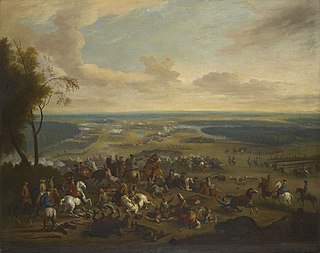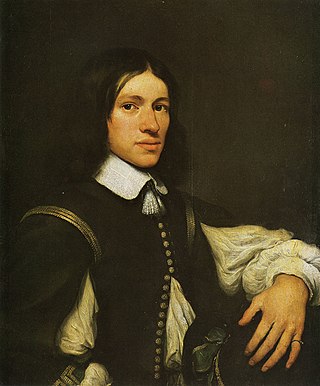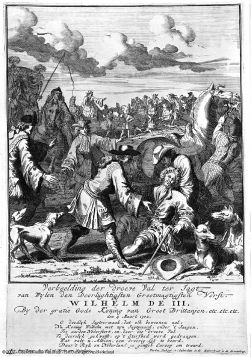
The Battle of Blenheim fought on 13 August [O.S. 2 August] 1704, was a major battle of the War of the Spanish Succession. The overwhelming Allied victory ensured the safety of Vienna from the Franco-Bavarian army, thus preventing the collapse of the reconstituted Grand Alliance.

John William Friso became the (titular) Prince of Orange in 1702. He was the Stadtholder of Friesland and Groningen in the Dutch Republic until his death by accidental drowning in the Hollands Diep in 1711. From 1938 to 2022, Friso and his wife, Marie Louise, were the most recent common ancestors of all then-reigning European monarchs. As of 2023, the most recent common ancestors of all currently-reigning European monarchs are Louis IX, Landgrave of Hesse-Darmstadt and his wife Countess Palatine Caroline of Zweibrücken.

General John Churchill, 1st Duke of Marlborough, 1st Prince of Mindelheim, 1st Count of Nellenburg, Prince of the Holy Roman Empire, was an English soldier and statesman. From a gentry family, he served as a page at the court of the House of Stuart under James, Duke of York, through the 1670s and early 1680s, earning military and political advancement through his courage and diplomatic skill. He is known for never having lost a battle.

The Battle of Denain was fought on 24 July 1712 as part of the War of the Spanish Succession. It resulted in a French victory, under Marshal Villars, against Dutch and Austrian forces, under Prince Eugene of Savoy.

The Battle of Malplaquet took place on 11 September 1709 during the War of the Spanish Succession, near Taisnières-sur-Hon in modern France, then part of the Spanish Netherlands. A French army of around 75,000 men, commanded by the Duke of Villars, engaged a Grand Alliance force of 86,000 under the Duke of Marlborough. In one of the bloodiest battles of the 18th century, the Allies won a narrow victory, but suffered heavy casualties.

The Battle of Oudenarde, also known as the Battle of Oudenaarde, was a major engagement of the War of the Spanish Succession, pitting a Grand Alliance force consisting of eighty thousand men under the command of the Duke of Marlborough and Prince Eugene of Savoy against a French force of eighty-five thousand men under the command of the Duc de Bourgogne and the Duc de Vendôme, the battle resulting in a great victory for the Grand Alliance. The battle was fought near the city of Oudenaarde, at the time part of the Spanish Netherlands, on 11 July 1708. With this victory, the Grand Alliance ensured the fall of various French territories, giving them a significant strategic and tactical advantage during this stage of the war. The battle was fought in the later years of the war, a conflict that had come about as a result of English, Dutch and Habsburg apprehension at the possibility of a Bourbon succeeding the deceased King of Spain, Charles II, and combining their two nations and empires into one.

Anthonie Heinsius was a Dutch statesman who served as Grand Pensionary of Holland from 1689 to his death in 1720. Heinsius was a tough negotiator and one of the greatest and most obstinate opponents of the expansionist policies of Louis XIV's France. He was one of the driving forces behind the anti-France coalitions of the Nine Years' War (1688–97) and the War of the Spanish Succession (1701–14).
The Battle of Walcourt was fought on 25 August 1689 during the Nine Years' War. The action took place near the ancient walled town of Walcourt near Charleroi in the Spanish Netherlands, and brought to a close a summer of uneventful marching, manoeuvring, and foraging. The battle was a success for the Grand Alliance – the only significant engagement in the theatre during the campaign of 1689.

The Battle of Elixheim, 18 July 1705, also known as the Passage of the Lines of Brabant was a battle of the War of the Spanish Succession. The Duke of Marlborough successfully broke through the French Lines of Brabant, an arc of defensive fieldworks stretching in a seventy-mile arc from Antwerp to Namur. Although he was unable to bring about a decisive battle, the breaking and subsequent razing of the lines would prove critical to the allied victory at Ramillies the next year.

The Battle of Ekeren, which took place on 30 June 1703, was a battle of the War of the Spanish Succession. A Bourbon army of around 24,000 men, conisting of troops from France, Spain and Cologne, surrounded a smaller Dutch force of 12,000 men, which however managed to break out and retire to safety.

Frederik Johan van Baer, Lord of Slangenburg was a Dutch officer in the military service of the Dutch States Army. He served under William III of Orange in the Franco-Dutch War and Nine Years' War. He was to become a controversial figure for his role in the War of the Spanish Succession. While a talented general, he possessed a very difficult character. Slangenburg was often at odds with his fellow generals, especially the Allied commander-in-chief, the Duke of Marlborough. The hero status he acquired as a result of his conduct in the Battle of Ekeren couldn't prevent his eventual dismissal during the 1705 campaign. Leading writer Thomas Lediard to remark that Slangenburg: lost by his tongue what he had gained by his sword.

The Second Stadtholderless Period or Era is the designation in Dutch historiography of the period between the death of stadtholder William III on 19 March 1702, and the appointment of William IV as stadtholder and captain general in all provinces of the Dutch Republic on 2 May 1747. During this period the office of stadtholder was left vacant in the provinces of Holland, Zeeland, and Utrecht, though in other provinces that office was filled by members of the House of Nassau-Dietz during various periods. During the period the Republic lost its status as a great power and its primacy in world trade. Though its economy declined considerably, causing deindustralization and deurbanization in the maritime provinces, a rentier-class kept accumulating a large capital fund that formed the basis for the leading position the Republic achieved in the international capital market. A military crisis at the end of the period caused the fall of the States-Party regime and the restoration of the Stadtholderate in all provinces. However, though the new stadtholder acquired near-dictatorial powers, this did not improve the situation.

Sicco van Goslinga was a Dutch statesman and diplomat, who served as field deputy of the States-General of the Dutch Republic with John Churchill, 1st Duke of Marlborough during his campaigns in Flanders in the War of the Spanish Succession. His memoirs form an important source of information for historians of the period.

The Dutch States Army was the army of the Dutch Republic. It was usually called this, because it was formally the army of the States-General of the Netherlands, the sovereign power of that federal republic. This army was brought to such a size and state of readiness that it was able to hold its own against the armies of the major European powers of the extended 17th century, Habsburg Spain and the France of Louis XIV, despite the fact that these powers possessed far larger military resources than the Republic. It played a major role in the Eighty Years' War and in the wars of the Grand Alliance with France after 1672.

Claude Frederic t'Serclaes, Count of Tilly, was a soldier and later general in the Dutch States Army. In the Dutch army he took part in the Franco-Dutch War, Nine Years' War and the War of the Spanish Succession and became its supreme commander in 1708.

The Bombardment of Arras took place during the War of the Spanish Succession on 2 and 3 March 1712. An Allied army under Arnold van Keppel, Earl of Albemarle closed in on Arras with the aim of destroying the supplies held there. In this way, they hoped that the French would not be able to prevent the sieges of Arras and Cambrai. Although the action succeeded, the advantage had to go entirely unused because the Emperor's troops arrived too late to the Allied army.
Frederik Sirtema van Grovestins was a Frisian officer in the Dutch States Army. He advanced through the various ranks in the army, from captain and cavalry captain (Ritmeester) to lieutenant-general of cavalry. Furthermore, he became general-quarter-master of the army and colonel of a regiment on foot at the repartition of Zeeland. In 1712 he became governor of Bouchain, in 1718 of Bergen-op-Zoom. He was an outstanding cavalry commander who played an important role in various campaigns and battles. He also was an excellent military theorist, who stressed to the cavalry of the Allies to seek their strength in combat with the bladed weapon, something that possibly influenced Friedrich Wilhelm von Seydlitz when he developed the Prussian cavalry later in the 18th century.
Jacques-Louis, Comte de Noyelles was a Walloon military officer in the service of the Dutch Republic between 1672 and 1708. He was also named an Austrian Field Marshal. He served in the Franco-Dutch War, the Glorious Revolution, the Nine Years' War, and the War of the Spanish Succession in both the northern and the Iberian theatres of that war.

Frederick Christiaan van Reede, 2nd Earl of Athlone, baron of Ginkel and Agrim, lord of Amerongen, was a Dutch general and diplomat in the service of the Dutch Republic during the Nine Years' War and the War of the Spanish Succession.

Daniël Wolf baron van Dopff was a prominent soldier in the Dutch Republic. He was, among other things, general of the cavalry of the Dutch States Army in the War of the Spanish Succession, Quartermaster general of that army, and later commander and governor of the fortress of Maastricht.

















